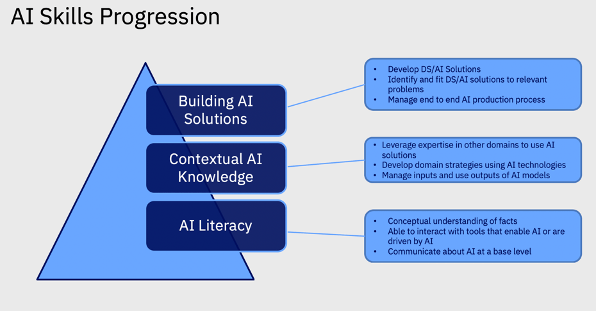Martech & Personalization
How AI can Affect your Digital Marketing Campaigns
It's one of the fastest technological shifts we've ever seen. AI tools are having their moment, and ...

Jun 19, 2023
6 min read
Artificial Intelligence (AI) is becoming an essential tool for digital marketing in enterprises. It helps automate tasks, kickstart innovation, and make processes more efficient.
There are so many possibilities, you might not know where to start. But in this article, you’ll see real-world examples of AI’s exciting applications in enterprise digital marketing. We'll unpack how everything from machine learning to generative AI can drive efficiencies and open up creative opportunities when smartly implemented at scale.
To help you in understanding the impact of using AI technology for marketing tasks, we’ve put together some of the most interesting and creative ways companies have approached it.
Not sure if your teams are capable of leading projects like these? We'll also look at the essential skills required to adopt AI across your enterprise.
Join us as we journey through five standout examples to inspire your own AI-fuelled marketing endeavours. But first – a little clarification.
The phrase AI (Artificial Antelligence) is used frequently these days to mean 'anything that involves large-scale computing'. So it's worth clarifying the different types of AI – for marketers, there are two you should be aware of.
Some examples make use of machine learning. This is a type of AI that's been around for a few years, but its different use cases continue to grow as methods become more refined.
It uses algorithms and statistical models to analyse large amounts of data and learn from patterns and trends to make predictions or take actions. It involves training software to automatically identify customer segments, optimise marketing campaigns, personalise content, and improve decision-making processes.
Others make use of generative AI, which hit the limelight in late 2022. This usually refers to tools that create content, like text, images, video and code. It's most well-known iteration is ChatGPT, a Large Language Model (LLM) that produces coherent writing on any topic you can think of. The underlying technology is frequently used for all sorts of marketing activities.
Both of these broad fields of AI have exciting applications in enterprise because they're built to scale, and can create vast new efficiencies and creative opportunities if they're deployed smartly.
A third option is also quite common – some brands simply combine different technologies to achieve an interesting outcome and call it ‘AI’. This happens a lot in consumer-facing brands, where 'AI' is often used to describe any kind of interactive data experience.
To inspire your next AI-based project, we've put together some uses cases of AI in marketing. These examples show enterprise-scale companies that have used these types of AI successfully in their digital marketing strategies.
Vanguard, one of the world's largest investment firms, increased its conversion rates by 15% using AI. They made use of analytical and generative AI tech to create more engaging and compliant advertising content for their highly regulated industry.
Vanguard Institutional (VI) wanted to evolve their marketing approach to better personalise their customer experiences. Because the division focuses on B2B sales to other institutions, their target audience of retirement plan sponsors was fairly narrow. VI struggled to determine which words were adding value to their marketing messages and inspiring action.
So the marketing team did A/B testing with their marketing messages, but they lacked testing capacity, so they decided it was time to leverage the newest technologies. They used Persado, an AI content generation and decision-making platform, to create highly effective personalised language, faster than a human team could write. The result was a 15% increase in click-through rates for their outbound prospecting messages.
ClickUp, the cloud-based project management software company, was valued at over $4bn in 2021. Its recent growth plans required a serious uplift in web traffic, with blog content serving as a major part of it.
ClickUP's content team used SurferSEO, one of the most popular AI marketing tools. It’s an AI-powered content optimisation platform, and ClickUp used it to improve the structure, targeting and content of 150+ blog articles.
With SurferSEO powering ClickUp’s content operations, they grew organic, non-branded traffic by 85%, published 150+ blogs, and completed 130+ page optimisations. They had several key articles where SurferSEO was an instrumental tool in its improvement.
There are various alternatives to SurferSEO, but it's a good demonstration of how AI tools can be used at scale to improve search performance for entire brand libraries of content.
It's impossible to talk about the use of AI in digital marketing without mentioning chatbots, and this is a great example.
Aveda, an Estée Lauder Company, is a leading botanical hair and skincare brand that offers plant-based products and promotes environmental sustainability. Aveda's retail stores also provide complimentary experiences to educate and excite customers about their products. But Aveda's online appointment booking system was under-promoted and lacked automation, so it was tedious for customers to input information through several rows of form fields. Aveda wanted to promote their services and increase foot traffic to their stores, and so sought a more engaging booking experience.
Aveda collaborated with Master of Code to create an AI booking chatbot. This allowed users to select their nearest Aveda store, book a complimentary beauty service, and confirm their appointment all within a single, engaging chatbot experience. To further promote Aveda's services, a paid social campaign was launched on Facebook and Instagram, featuring a special offer.
The technologies used included engaging conversational design, Google's API for zip code detection, Aveda's booking platform API, robust natural language processing (NLP) training, and logic to keep users engaged, even with unexpected inputs. (Essentially, it was a blend of AI and programming expertise).
The results were really positive. The custom booking chatbot flow was used for a social campaign that ran for seven weeks in January and February 2019. During this period, there was a 378% growth in lifetime users from campaign launch, 6,918 bookings were made, there was a 7x increase in average weekly bookings since the chatbot was launched, and a 33.2% booking conversion rate was achieved from an 11-step chatbot flow.
Overall, these powerful chatbot features significantly improved the user experience. And in the short few years since this case study occurred, chatbot technology has advanced rapidly, so they’re now much easier to deploy across an enterprise. One study claims that up to 30% of operational costs can potentially be saved by using a chatbot.
Alibaba, the Chinese e-commerce giant, uses AI for customer service, logistics optimisation, and product recommendations. They've also developed an AI-powered "FashionAI" system that provides personalised fashion recommendations to customers.
This is one of those ‘combination of different technology’ types of AI.
Alibaba's "FashionAI" concept store innovates the shopping experience with its creative use of AI. One of the main features is the introduction of intelligent garment tags, which are equipped with radio-frequency identification (RFID), gyro-sensors, and low-energy Bluetooth chips. These tags, attached to each product, provide detailed information about the item, such as its colour and size, and can even track if the item is being touched or moved.
Another interesting feature is the use of smart mirrors placed on the sales floor and in changing rooms. These mirrors have touch screens that use the information from the intelligent garment tags to display data about the products customers are interacting with. As well as providing product information, these mirrors can suggest complementary apparel, locate products in the store, add items to a virtual shopping cart, and facilitate size and colour requests directly from the fitting rooms. It can pretty much do anything.
Alibaba's integration of its Mobile Taobao app with the store experience brought a new level of omnichannel retailing. A feature called "Virtual Wardrobe" allows customers to view clothes they tried on in-store along, with recommendations for complementary items from other merchants on Alibaba's shopping sites. This AI-powered fusion of online and offline shopping allows Alibaba to rapidly adapt to consumer fashion trends.
Bouygues Telecom is one of France's leading telecoms operators, running fixed and mobile 5G infrastructure throughout the nation.
This is a sector with an appetite for innovation, and one that processes vast amounts of data, so it was a perfect fit for a future-facing AI plan.
IBM, one of the world's leading computer system providers, led Bouygues through a program of AI innovation across the whole enterprise. This form of 'digital transformation' empowered all business and IT functions to "to create, develop and deploy their own cloud-native AI apps."
The marketing and sales teams certainly didn't miss out in this massive project. An AI-powered app was implemented to triage and route customer queries that were being submitted through the wrong form:
"Using the new AI app, the qualification call centre can automatically sort out irrelevant information, speeding lead generation for sales teams and dramatically reducing costs for Bouygues Telecom."
This organisation-level AI rollout means creative marketing and customer service are only going to improve as the company evolves.
To introduce an AI program throughout your organization, you'll need to have people with the right skills to do it. Depending on your current situation, you might already be equipped to do it. Or you could have a significant capability gap that's getting in the way of your progress.
So we'd recommend running a capability gap analysis to clarify what's next for your learning plans.
With AI, you'll probably need to seek external education to bridge that gap. So it's a good idea to consider the different types of upskilling available and how you can find the right learning provider.
 Image source: IBM
Image source: IBMFor the AI Literacy stage, Circus Street can help your teams begin their journey, with our AI for Marketing course. There’s also courses in Big Data, Analytics, and Personalization – which are all fundamental to the use of AI in marketing. Why not explore the range of courses today?
It's one of the fastest technological shifts we've ever seen. AI tools are having their moment, and ...
Martech - short for marketing technology, encompasses all of the software, technology, tools and pla...
Social selling has emerged as a powerful strategy for businesses across all sectors, including B2C, ...
Get in touch and we can start helping with your digital learning journey.